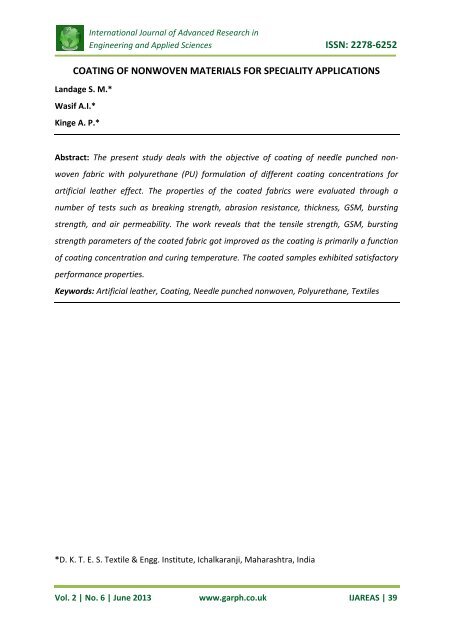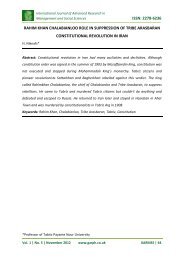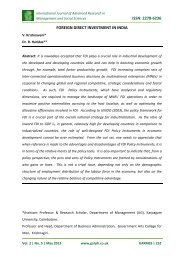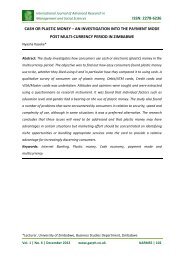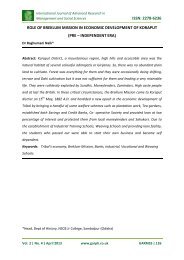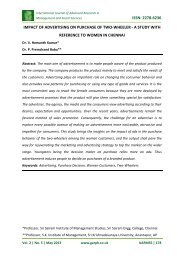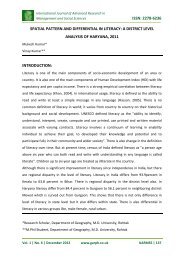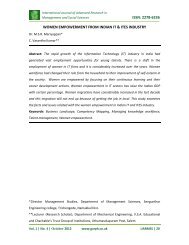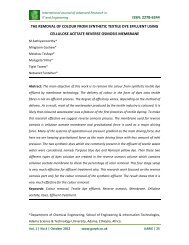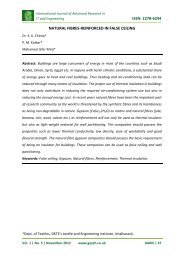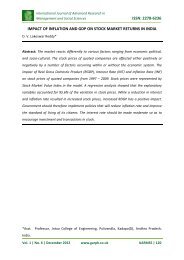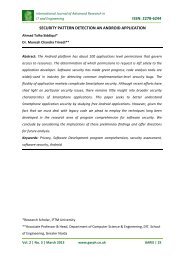issn: 2278-6252 coating of nonwoven materials for ... - Garph.co.uk
issn: 2278-6252 coating of nonwoven materials for ... - Garph.co.uk
issn: 2278-6252 coating of nonwoven materials for ... - Garph.co.uk
You also want an ePaper? Increase the reach of your titles
YUMPU automatically turns print PDFs into web optimized ePapers that Google loves.
International Journal <strong>of</strong> Advanced Research in<br />
Engineering and Applied Sciences ISSN: <strong>2278</strong>-<strong>6252</strong><br />
COATING OF NONWOVEN MATERIALS FOR SPECIALITY APPLICATIONS<br />
Landage S. M.*<br />
Wasif A.I.*<br />
Kinge A. P.*<br />
Abstract: The present study deals with the objective <strong>of</strong> <strong><strong>co</strong>ating</strong> <strong>of</strong> needle punched <strong>nonwoven</strong><br />
fabric with polyurethane (PU) <strong>for</strong>mulation <strong>of</strong> different <strong><strong>co</strong>ating</strong> <strong>co</strong>ncentrations <strong>for</strong><br />
artificial leather effect. The properties <strong>of</strong> the <strong>co</strong>ated fabrics were evaluated through a<br />
number <strong>of</strong> tests such as breaking strength, abrasion resistance, thickness, GSM, bursting<br />
strength, and air permeability. The work reveals that the tensile strength, GSM, bursting<br />
strength parameters <strong>of</strong> the <strong>co</strong>ated fabric got improved as the <strong><strong>co</strong>ating</strong> is primarily a function<br />
<strong>of</strong> <strong><strong>co</strong>ating</strong> <strong>co</strong>ncentration and curing temperature. The <strong>co</strong>ated samples exhibited satisfactory<br />
per<strong>for</strong>mance properties.<br />
Keywords: Artificial leather, Coating, Needle punched <strong>nonwoven</strong>, Polyurethane, Textiles<br />
*D. K. T. E. S. Textile & Engg. Institute, Ichalkaranji, Maharashtra, India<br />
Vol. 2 | No. 6 | June 2013 www.garph.<strong>co</strong>.<strong>uk</strong> IJAREAS | 39
International Journal <strong>of</strong> Advanced Research in<br />
Engineering and Applied Sciences ISSN: <strong>2278</strong>-<strong>6252</strong><br />
1. INTRODUCTION:<br />
Speciality <strong>co</strong>ated fabrics <strong>co</strong>mbine the beneficial properties <strong>of</strong> a textile and a polymer, the<br />
textile <strong>co</strong>mponent providing the tensile strength, tearing strength, and elongation <strong>co</strong>ntrol<br />
and <strong><strong>co</strong>ating</strong> <strong>of</strong>fering protection against the environment to which the fabric is subjected [1].<br />
Coated textiles have established themselves as one <strong>of</strong> the important products in the global<br />
textile market. Micro level modification <strong>of</strong> the end product is actually governed by choosing<br />
proper <strong><strong>co</strong>ating</strong> technique. Coatings enhance and extend the range <strong>of</strong> functional<br />
per<strong>for</strong>mance properties <strong>of</strong> textile, and the use <strong>of</strong> these techniques is increasing rapidly as<br />
the applications <strong>for</strong> technical textiles. Cheaper or loose fabric structure may be <strong>co</strong>ated to<br />
provide higher added value to end- users and to get pr<strong>of</strong>it margins <strong>for</strong> manufactures. The<br />
success in textile <strong><strong>co</strong>ating</strong> depends upon the application method used <strong>for</strong> <strong><strong>co</strong>ating</strong> [2, 3].<br />
The <strong><strong>co</strong>ating</strong> is a process in which a polymeric layer is applied to one or both surfaces <strong>of</strong> the<br />
fabric. Depending upon the end use requirements, heavy-duty technical textile <strong><strong>co</strong>ating</strong>s may<br />
be applied at high weight, while other end- uses <strong>for</strong> high-technology apparel may require<br />
<strong><strong>co</strong>ating</strong> weights very low. The <strong><strong>co</strong>ating</strong> <strong>for</strong>mulation, the <strong><strong>co</strong>ating</strong> thickness, weight, the<br />
number <strong>of</strong> layers, the <strong>for</strong>m <strong>of</strong> the technical textile and nature <strong>of</strong> any pretreatment are <strong>of</strong><br />
great importance [4]. Coatings <strong>of</strong> the textiles achieve high level <strong>of</strong> functional per<strong>for</strong>mance<br />
than that is possible from un<strong>co</strong>ated textiles. The <strong><strong>co</strong>ating</strong>s used in technical textiles are all<br />
the thermoplastic polymers, which are long chain linear molecules, some <strong>of</strong> which have the<br />
ability to crosslink as the <strong>co</strong>ated fabrics dried and cured after <strong><strong>co</strong>ating</strong> [5]. The rapid<br />
development and major upsurge in the <strong>co</strong>ated technology is manifold especially with the<br />
introduction <strong>of</strong> water based PU <strong><strong>co</strong>ating</strong>s. The PU based <strong>co</strong>ated fabrics because <strong>of</strong> its<br />
meritorious properties has projected its use in the production <strong>of</strong> artificial leather effect [6,<br />
7]. Various fabrics are used in production <strong>of</strong> <strong>co</strong>ated fabrics like woven, <strong>nonwoven</strong>, and<br />
knitted.<br />
In the present study needle punched fabric is preferred due to its properties like they<br />
maintain their <strong>for</strong>m; they are porous in nature, durable, having good mechanical properties<br />
and elasticity [8, 9]. Besides these <strong>nonwoven</strong>s are s<strong>of</strong>t with good hand, can easily cut, sewn<br />
and glued together. They have uni<strong>for</strong>m properties in all directions. As these properties are<br />
required in the production <strong>of</strong> artificial leather <strong>nonwoven</strong> fabrics are generally used [10, 11,<br />
12].<br />
Vol. 2 | No. 6 | June 2013 www.garph.<strong>co</strong>.<strong>uk</strong> IJAREAS | 40
International Journal <strong>of</strong> Advanced Research in<br />
Engineering and Applied Sciences ISSN: <strong>2278</strong>-<strong>6252</strong><br />
The present paper deals with <strong><strong>co</strong>ating</strong> <strong>of</strong> <strong>nonwoven</strong> <strong>materials</strong> with PU <strong>for</strong>mulation at<br />
different <strong><strong>co</strong>ating</strong> <strong>co</strong>ncentrations on <strong>co</strong>ntinuous knife- roller <strong><strong>co</strong>ating</strong> machine. These<br />
developments <strong>of</strong> PU <strong>co</strong>ated needle punched fabric are used as a one <strong>of</strong> the <strong>co</strong>mponents in<br />
artificial leather products [13, 14]. The effect <strong>of</strong> <strong><strong>co</strong>ating</strong> <strong>co</strong>ncentration on physical properties<br />
are reviewed, <strong>co</strong>mpared, and discussed.<br />
2. MATERIALS AND METHODS<br />
2.1 Material:<br />
In the present work, needle punched <strong>nonwoven</strong> fabric <strong>for</strong> <strong><strong>co</strong>ating</strong> is procured from Tata<br />
Mills Dadar, Mumbai. Polyurethane (water based) is procured from Clariant chemicals,<br />
Mumbai.<br />
2.2 Methods:<br />
The <strong><strong>co</strong>ating</strong> <strong>of</strong> <strong>nonwoven</strong> fabric is carried out using following <strong>for</strong>mulations<br />
Appretan PUL liq<br />
Sili<strong>co</strong>n s<strong>of</strong>tener<br />
- 10-90 Parts<br />
- 1-2 Parts<br />
Fixer CCL - 1-2 Parts<br />
Synthetic thickener - 1-2 Parts<br />
Pigment - 1 Part<br />
Coat- cure 170° c <strong>for</strong> 90 Sec<br />
3. TEST PROCEDURES:<br />
The following tests are per<strong>for</strong>med in evaluating the <strong><strong>co</strong>ating</strong> properties Breaking Strength:<br />
ISO 9073- 4: 1997 (E), Air permeability: ASTM D 5035- 95, Thickness: ISO 9073- 2: 1995 (E),<br />
Bursting strength: ASTM D 6707- 02, Abrasion resistance: ASTM D 6770, GSM: ASTM D 3776<br />
4. RESULTS AND DISCUSSION<br />
Tests were <strong>co</strong>nducted <strong>for</strong> testing the Tensile strength, Bursting strength, Air permeability, &<br />
GSM <strong>of</strong> the needle punched <strong>nonwoven</strong> fabric treated polyurethane with different<br />
<strong>co</strong>ncentration and with different thickness.<br />
For 0.5 mm Thickness<br />
Table 4.1 Effect <strong>of</strong> <strong>co</strong>ncentration <strong>of</strong> PU on GSM <strong>of</strong> fabric.<br />
Concentration (g/l)<br />
0 10 20 30 40 50 60 70 80 90<br />
GSM 332 511.8 517.2 535.2 534.4 541.2 546 549.8 550.2 558<br />
Vol. 2 | No. 6 | June 2013 www.garph.<strong>co</strong>.<strong>uk</strong> IJAREAS | 41
GSM<br />
GSM<br />
International Journal <strong>of</strong> Advanced Research in<br />
Engineering and Applied Sciences ISSN: <strong>2278</strong>-<strong>6252</strong><br />
600<br />
Effect <strong>of</strong> <strong>co</strong>ncentration on GSM<br />
500<br />
400<br />
300<br />
200<br />
GSM<br />
100<br />
0<br />
0 10 20 30 40 50 60 70 80 90<br />
Concentration (g/l)<br />
Fig 4.1:- Effect <strong>of</strong> <strong>co</strong>ncentration <strong>of</strong> PU on GSM <strong>of</strong> fabric.<br />
From Table 4.1 and Figure 4.1 indicate that as the <strong>co</strong>ncentration <strong>of</strong> polyurethane increases<br />
from 10 g/l to 90 g/l, the values <strong>of</strong> GSM increases from 511.8 to 558. This is may be due to<br />
the increase in the <strong><strong>co</strong>ating</strong> layer on the fabric surface.<br />
For 1.0 mm Thickness<br />
Table 4.2 Effect <strong>of</strong> <strong>co</strong>ncentration <strong>of</strong> PU on GSM <strong>of</strong> fabric.<br />
Concentration (g/l)<br />
0 10 20 30 40 50 60 70 80 90<br />
GSM 332 540.8 550.6 560.8 553.8 557.6 561.6 561.6 563.6 573<br />
700<br />
600<br />
500<br />
400<br />
300<br />
200<br />
100<br />
0<br />
Effect <strong>of</strong> <strong>co</strong>ncentration on GSM<br />
0 10 20 30 40 50 60 70 80 90<br />
Concentration (g/l)<br />
GSM<br />
Fig 4.2:- Effect <strong>of</strong> <strong>co</strong>ncentration <strong>of</strong> PU on GSM <strong>of</strong> fabric<br />
Vol. 2 | No. 6 | June 2013 www.garph.<strong>co</strong>.<strong>uk</strong> IJAREAS | 42
Air permeability (cm³/cm²/sec)<br />
International Journal <strong>of</strong> Advanced Research in<br />
Engineering and Applied Sciences ISSN: <strong>2278</strong>-<strong>6252</strong><br />
From Table 4.2 and Figure 4.2 indicate that as the <strong>co</strong>ncentration <strong>of</strong> polyurethane increases<br />
from 10 g/l to 90 g/l, the values <strong>of</strong> GSM increases from 540.8 to 573. This may be due to the<br />
increase in the <strong><strong>co</strong>ating</strong> layer on the fabric surface. Also it is observed that as the thickness <strong>of</strong><br />
PU <strong>co</strong>at increases there is an increase in GSM <strong>of</strong> fabric too. This may be because <strong>of</strong><br />
deposition <strong>of</strong> more quantity <strong>of</strong> PU <strong>co</strong>at on substrate.<br />
For 0.5 mm Thickness<br />
Table 4.3 Effect <strong>of</strong> <strong>co</strong>ncentration <strong>of</strong> PU on Air permeability <strong>of</strong> fabric.<br />
Air<br />
perme<br />
ability<br />
Concentration (g/l)<br />
0 10 20 30 40 50 60 70 80 90<br />
18.25 11.69 11.67 11.68 10.04 10.74 10.77 9.52 9.56 9.47<br />
20<br />
18<br />
16<br />
14<br />
12<br />
10<br />
8<br />
6<br />
4<br />
2<br />
0<br />
Effect <strong>of</strong> <strong>co</strong>ncentration on Air permeability<br />
Air permeability<br />
0 10 20 30 40 50 60 70 80 90<br />
Concentration (g/l)<br />
Fig 4.3:- Effect <strong>of</strong> <strong>co</strong>ncentration <strong>of</strong> PU on Air permeability <strong>of</strong> fabric.<br />
From Table 4.3 and Figure 4.3 it can be said that as the <strong>co</strong>ncentration <strong>of</strong> PU increases from<br />
10 g/l to 90g/l, the air permeability values decreases from 11.69 to 9.47 respectively. The<br />
minimum air permeability value was found to be 9.47 <strong>for</strong> 90 g/l PU <strong>co</strong>ncentrations at 0.5<br />
mm <strong>of</strong> thickness. The decrease in air permeability values may be due to the presence PU<br />
which <strong>for</strong>ms a <strong><strong>co</strong>ating</strong> layer on the fabric surface. Also the curing temperature at 170 ° C<br />
may attribute to higher cross linking efficiency <strong>of</strong> <strong>co</strong>ated fabrics.<br />
Vol. 2 | No. 6 | June 2013 www.garph.<strong>co</strong>.<strong>uk</strong> IJAREAS | 43
Air permeability (cm³/cm²/sec)<br />
International Journal <strong>of</strong> Advanced Research in<br />
Engineering and Applied Sciences ISSN: <strong>2278</strong>-<strong>6252</strong><br />
For 1.0 mm Thickness<br />
Table 4.4 Effect <strong>of</strong> <strong>co</strong>ncentration <strong>of</strong> PU on Air permeability <strong>of</strong> fabric.<br />
Air<br />
perme<br />
ability<br />
Concentration (g/l)<br />
0 10 20 30 40 50 60 70 80 90<br />
18.25 6.25 6.25 6.11 5.41 4.64 4.51 2.37 1.21 1.17<br />
20<br />
18<br />
16<br />
14<br />
12<br />
10<br />
8<br />
6<br />
4<br />
2<br />
0<br />
Effect <strong>of</strong> <strong>co</strong>ncentration on Air permeability<br />
Air permeability<br />
0 10 20 30 40 50 60 70 80 90<br />
Concentration (g/l)<br />
Fig 4.4:- Effect <strong>of</strong> <strong>co</strong>ncentration <strong>of</strong> PU on Air permeability <strong>of</strong> fabric.<br />
From Table 4.4 and Figure 4.4 indicates that as the <strong>co</strong>ncentration <strong>of</strong> PU increases from 10<br />
g/l to 90g/l, the air permeability values decreases from 6.25 to 1.17 respectively. The<br />
minimum air permeability value was found to be 1.17 <strong>for</strong> 90 g/l PU <strong>co</strong>ncentrations at 1 mm<br />
<strong>of</strong> thickness. The decrease in air permeability values may be due to the presence PU which<br />
<strong>for</strong>ms a <strong><strong>co</strong>ating</strong> layer on the fabric surface. Also the curing temperature at 170 ° C may<br />
attribute to higher cross linking efficiency <strong>of</strong> <strong>co</strong>ated fabrics.<br />
For 0.5 mm Thickness<br />
Table 4.5 Effect <strong>of</strong> <strong>co</strong>ncentration <strong>of</strong> PU on Bursting strength <strong>of</strong> fabric.<br />
Bursting<br />
strength<br />
Concentration (g/l)<br />
0 10 20 30 40 50 60 70 80 90<br />
19.46 23.82 24.6 25.08 26.66 27.44 31.22 33.49 33.80 35.20<br />
Vol. 2 | No. 6 | June 2013 www.garph.<strong>co</strong>.<strong>uk</strong> IJAREAS | 44
Bursting strength (bar)<br />
International Journal <strong>of</strong> Advanced Research in<br />
Engineering and Applied Sciences ISSN: <strong>2278</strong>-<strong>6252</strong><br />
40<br />
35<br />
30<br />
25<br />
20<br />
15<br />
10<br />
5<br />
0<br />
Effect <strong>of</strong> <strong>co</strong>ncentration on Bursting strength<br />
Bursting strength<br />
0 10 20 30 40 50 60 70 80 90<br />
Concentration (g/l)<br />
Fig 4.5:- Effect <strong>of</strong> <strong>co</strong>ncentration <strong>of</strong> PU on Bursting strength <strong>of</strong> fabric.<br />
From Table 4.5 and Figure 4.5 indicate that as the <strong>co</strong>ncentration <strong>of</strong> PU increases from 10 g/l<br />
to 90g/l, the bursting strength value increases from 23.82 to 35.20 respectively. The<br />
maximum bursting strength value was found to be 35.20 <strong>for</strong> 90 g/l PU <strong>co</strong>ncentrations at 0.5<br />
mm <strong>of</strong> thickness. The increase in bursting strength values may be due to the presence PU<br />
which <strong>for</strong>ms a <strong><strong>co</strong>ating</strong> layer on the fabric surface. As the <strong>co</strong>ncentration <strong>of</strong> PU increases from<br />
10 gpl – 90 gpl, the film <strong>for</strong>ming tendency or cross linking efficiency <strong>of</strong> <strong>co</strong>ated fabric<br />
increases which causes requires more energy to break the thicker film <strong>for</strong>m, this can be<br />
supported by the thickness <strong>of</strong> fabric after <strong><strong>co</strong>ating</strong>.<br />
For 1.0 mm Thickness<br />
Table 4.6 Effect <strong>of</strong> <strong>co</strong>ncentration <strong>of</strong> PU on Bursting strength <strong>of</strong> fabric.<br />
Bursting<br />
strength<br />
Concentration (g/l)<br />
0 10 20 30 40 50 60 70 80 90<br />
19.46 31.91 34.82 36.15 39.62 41.36 42.59 43.25 46.01 48.93<br />
Vol. 2 | No. 6 | June 2013 www.garph.<strong>co</strong>.<strong>uk</strong> IJAREAS | 45
Bursting strength (bar)<br />
International Journal <strong>of</strong> Advanced Research in<br />
Engineering and Applied Sciences ISSN: <strong>2278</strong>-<strong>6252</strong><br />
60<br />
Effect <strong>of</strong> <strong>co</strong>ncentration on Bursting strength<br />
50<br />
40<br />
30<br />
20<br />
Bursting strength<br />
10<br />
0<br />
0 10 20 30 40 50 60 70 80 90<br />
Concentration (g/l)<br />
Fig 4.6:- Effect <strong>of</strong> <strong>co</strong>ncentration <strong>of</strong> PU on Bursting strength <strong>of</strong> fabric.<br />
From Table 4.6 and Figure 4.6 indicate that as the <strong>co</strong>ncentration <strong>of</strong> PU increases from 10 g/l<br />
to 90g/l, the bursting strength value increases from 31.91 to 48.93 respectively. The<br />
maximum bursting strength value was found to be 48.93 <strong>for</strong> 90 g/l PU <strong>co</strong>ncentrations at 1<br />
mm <strong>of</strong> thickness. The increase in bursting strength values may be due to the presence PU<br />
which <strong>for</strong>ms a <strong><strong>co</strong>ating</strong> layer on the fabric surface. As the <strong>co</strong>ncentration <strong>of</strong> PU increases from<br />
10 gpl – 90 gpl, the film <strong>for</strong>ming tendency or cross linking efficiency <strong>of</strong> <strong>co</strong>ated fabric<br />
increases which causes requires more energy to break the thicker film <strong>for</strong>m, this can be<br />
supported by the thickness <strong>of</strong> fabric after <strong><strong>co</strong>ating</strong>.<br />
For 0.5 mm Thickness<br />
Table 4.7 Effect <strong>of</strong> <strong>co</strong>ncentration <strong>of</strong> PU on Tensile strength <strong>of</strong> fabric.<br />
Tensile<br />
strength<br />
Concentration (g/l)<br />
0 10 20 30 40 50 60 70 80 90<br />
40.11 60.11 62.24 62.52 65.11 69.12 71.24 73.19 75.00 79.00<br />
Vol. 2 | No. 6 | June 2013 www.garph.<strong>co</strong>.<strong>uk</strong> IJAREAS | 46
Tensile strength (kgf)<br />
International Journal <strong>of</strong> Advanced Research in<br />
Engineering and Applied Sciences ISSN: <strong>2278</strong>-<strong>6252</strong><br />
90<br />
80<br />
70<br />
60<br />
50<br />
40<br />
30<br />
20<br />
10<br />
0<br />
Effect <strong>of</strong> <strong>co</strong>ncentration on Tensile strength<br />
Tensile strength<br />
0 10 20 30 40 50 60 70 80 90<br />
Concentration (g/l)<br />
Fig 4.7:- Effect <strong>of</strong> <strong>co</strong>ncentration <strong>of</strong> PU on Tensile strength <strong>of</strong> fabric.<br />
From Table 4.7 and Figure 4.7 indicate that as the <strong>co</strong>ncentration <strong>of</strong> PU increases from 10 g/l<br />
to 90g/l, the tensile strength values increased from 60.11 to 79.00 respectively. The<br />
maximum tensile strength value was found to be 79.00 <strong>for</strong> 90 g/l PU <strong>co</strong>ncentrations at 0.5<br />
mm <strong>of</strong> thickness. The increase in tensile strength values may be due to the presence PU<br />
which <strong>for</strong>ms a <strong><strong>co</strong>ating</strong> layer on the fabric surface. Also curing temperature may attribute to<br />
higher cross linking efficiency and more energy is required to break the film <strong>for</strong>med at<br />
higher <strong>co</strong>ncentration.<br />
For 1.0 mm Thickness<br />
Table 4.8 Effect <strong>of</strong> <strong>co</strong>ncentration <strong>of</strong> PU on Tensile strength <strong>of</strong> fabric.<br />
Tensile<br />
strength<br />
Concentration (g/l)<br />
0 10 20 30 40 50 60 70 80 90<br />
40.11 113.25 118.28 122.24 127.21 130.31 132.2 137.1 142.2 159.1<br />
4 4 0 1<br />
Vol. 2 | No. 6 | June 2013 www.garph.<strong>co</strong>.<strong>uk</strong> IJAREAS | 47
Tensile strength (kgf)<br />
International Journal <strong>of</strong> Advanced Research in<br />
Engineering and Applied Sciences ISSN: <strong>2278</strong>-<strong>6252</strong><br />
180<br />
160<br />
140<br />
120<br />
100<br />
80<br />
60<br />
40<br />
20<br />
0<br />
Effect <strong>of</strong> <strong>co</strong>ncentration on Tensile strength<br />
Tensile strength<br />
0 10 20 30 40 50 60 70 80 90<br />
Concentration (g/l)<br />
Fig 4.8:- Effect <strong>of</strong> <strong>co</strong>ncentration <strong>of</strong> PU on Tensile strength <strong>of</strong> fabric.<br />
From Table 4.8 and Figure 4.8 indicate that as the <strong>co</strong>ncentration <strong>of</strong> PU increases from 10 g/l<br />
to 90g/l, the tensile strength values increased from 113.25 to 159.11 respectively. The<br />
maximum tensile strength value was found to be 159.11 <strong>for</strong> 90 g/l PU <strong>co</strong>ncentrations at 1<br />
mm <strong>of</strong> thickness. The increase in tensile strength values may be due to the presence PU<br />
which <strong>for</strong>ms a <strong><strong>co</strong>ating</strong> layer on the fabric surface. Also curing temperature may attribute to<br />
higher cross linking efficiency and more energy is required to break the film <strong>for</strong>med at<br />
higher <strong>co</strong>ncentration.<br />
For 0.5 mm Thickness<br />
Table 4.9 Effect <strong>of</strong> <strong>co</strong>ncentration <strong>of</strong> PU on Add on % <strong>of</strong> fabric.<br />
Concentration (g/l)<br />
0 10 20 30 40 50 60 70 80 90<br />
Add on<br />
%<br />
0 1.13 2.22 3 4.24 5.14 6.51 7 8 9.38<br />
Vol. 2 | No. 6 | June 2013 www.garph.<strong>co</strong>.<strong>uk</strong> IJAREAS | 48
Add on %<br />
Add on %<br />
International Journal <strong>of</strong> Advanced Research in<br />
Engineering and Applied Sciences ISSN: <strong>2278</strong>-<strong>6252</strong><br />
10<br />
9<br />
8<br />
7<br />
6<br />
5<br />
4<br />
3<br />
2<br />
1<br />
0<br />
Effect <strong>of</strong> <strong>co</strong>ncentration on Add on %<br />
0 10 20 30 40 50 60 70 80 90<br />
Concentration (g/l)<br />
Add on %<br />
Fig 4.9:- Effect <strong>of</strong> <strong>co</strong>ncentration <strong>of</strong> PU on Add on % <strong>of</strong> fabric.<br />
From Table 4.9 and Figure 4.9 indicate that as the <strong>co</strong>ncentration <strong>of</strong> polyurethane increases<br />
from 10 g/l to 90 g/l, the values <strong>of</strong> Add on increases from1.13 to 9.38. This is may be due to<br />
the increase in the <strong><strong>co</strong>ating</strong> layer on the fabric surface.<br />
For 1.0 mm Thickness<br />
Table 4.10 Effect <strong>of</strong> <strong>co</strong>ncentration <strong>of</strong> PU on Add on % <strong>of</strong> fabric.<br />
Add on<br />
%<br />
Concentration (g/l)<br />
0 10 20 30 40 50 60 70 80 90<br />
0 1.45 2.8 3.75 4.85 6.66 7.78 8.62 10.5 12.6<br />
14<br />
12<br />
10<br />
8<br />
6<br />
4<br />
2<br />
0<br />
Effect <strong>of</strong> <strong>co</strong>ncentration on Add on %<br />
0 10 20 30 40 50 60 70 80 90<br />
Concentration (g/l)<br />
Add on %<br />
Fig 4.10:- Effect <strong>of</strong> <strong>co</strong>ncentration <strong>of</strong> PU on Add on % <strong>of</strong> fabric.<br />
Vol. 2 | No. 6 | June 2013 www.garph.<strong>co</strong>.<strong>uk</strong> IJAREAS | 49
International Journal <strong>of</strong> Advanced Research in<br />
Engineering and Applied Sciences ISSN: <strong>2278</strong>-<strong>6252</strong><br />
From Table 4.10 and Figure 4.10 indicate that as the <strong>co</strong>ncentration <strong>of</strong> polyurethane<br />
increases from 10 g/l to 90 g/l, the values <strong>of</strong> Add on increases from1.45 to 12.6. This is may<br />
be due to the increase in the <strong><strong>co</strong>ating</strong> layer on the fabric surface.<br />
CONCLUSIONS<br />
From the above results and discussion we can <strong>co</strong>nclude that as the <strong>co</strong>ncentration <strong>of</strong> PU<br />
increases from 10 parts to 90 parts, there is an increase in values <strong>of</strong> GSM, tensile strength,<br />
thickness, bursting strength, and add on %. Also it is observed that there is desirable air<br />
permeability in both 0.5 and 1.0 mm thickness. The maximum tensile strength <strong>of</strong> 79.00 &<br />
159.11 was observed in <strong>for</strong>mulating recipes at 90 g/l polyurethane <strong>co</strong>ncentration in both 0.5<br />
mm and1 mm thickness respectively.<br />
REFERENCES<br />
1. Teli M. D., Sheikh J., Chemicals Used For Coating and Lamination, Mantra Textile<br />
Magazine, 05 (2), 1-5 (2010).<br />
2. Salgado C.., Textile Coating, Technitex Ingenieros S.L. www.fibre2fashion.<strong>co</strong>m<br />
3. Kovacevic S., Ujevic D., Brnada S., Coated textile <strong>materials</strong><br />
http://www.intechopen.<strong>co</strong>m/books/woven-fabric-engineering/<strong>co</strong>ated-textile<br />
4. Kusumgar Y. K., Tal<strong>uk</strong>dar M. K., Application <strong>of</strong> Coated Textiles-An Opportunity <strong>for</strong><br />
Indian Textile Industry, Journal <strong>of</strong> Textile Association, 60 (3), 275-279 (2000).<br />
5. Rekha V. D., Breathable Coatings, Man-Made Textiles in India, XLII (2), 67-70 (1999).<br />
6. Hall E. M., Coating <strong>of</strong> Technical Textiles, New Cloth Market, Jan-April 42-51 (2010).<br />
7. Shekar R. Indu., Kasturiya N., Hans Raj, Sen A. K., Bajpai U., Studies On PVC Coated<br />
Cotton Fabric, Man-Made Textiles In India, XLII (6), 215-220 (1999).<br />
8. Venkatesan H., Gowrishankar V. N., Coated and Laminated Textile Materials and<br />
Process. http://www.fibre2fashion.<strong>co</strong>m<br />
9. Mary J., Needle Punched Fabrics: An Overview, New Cloth Market, 8 (1), 13-20<br />
(1994).<br />
10. Brocks J., Coating technology- New horizons, Melliand, 69 (1), 33-35 (1988).<br />
11. Saurabh., Jahan S., Artificial Leather- An E<strong>co</strong>-friendly Alternative Textile Material <strong>for</strong><br />
Leather, China Textile Science, 3rd 2011.<br />
12. Hans H., Nonwoven Fabrics <strong>for</strong> Artificial Leather, Journal <strong>of</strong> Textile Association, 59<br />
(9), 157-157 (1998).<br />
Vol. 2 | No. 6 | June 2013 www.garph.<strong>co</strong>.<strong>uk</strong> IJAREAS | 50
International Journal <strong>of</strong> Advanced Research in<br />
Engineering and Applied Sciences ISSN: <strong>2278</strong>-<strong>6252</strong><br />
13. Anon, Artificial Leather, Real <strong>co</strong>m<strong>for</strong>t, Science Tech Entrepreneur, June 2000.<br />
http://www.jyxtplastic.<strong>co</strong>m/html-news/Artificial-leather-&Real<br />
14. Chaudhary S.N., Borkar S. P., Technical textiles in footwear, Asian Textile Journal, 17<br />
(5), 21-27 (2008).<br />
Vol. 2 | No. 6 | June 2013 www.garph.<strong>co</strong>.<strong>uk</strong> IJAREAS | 51


